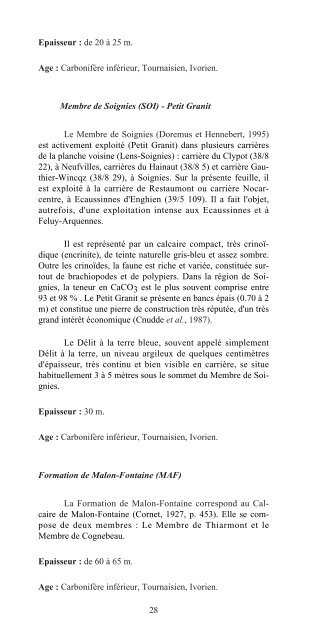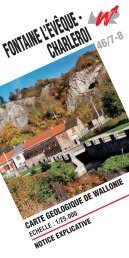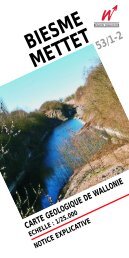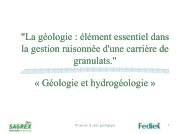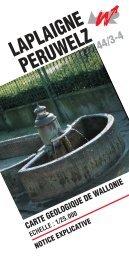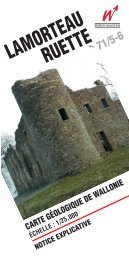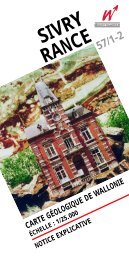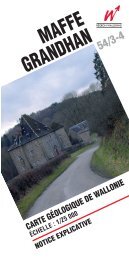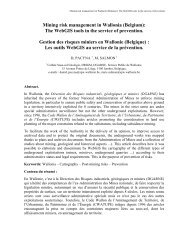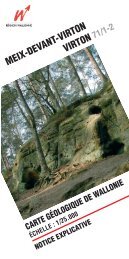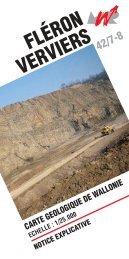braine-le-comte - feluy - Service de Géologie
braine-le-comte - feluy - Service de Géologie
braine-le-comte - feluy - Service de Géologie
You also want an ePaper? Increase the reach of your titles
YUMPU automatically turns print PDFs into web optimized ePapers that Google loves.
Epaisseur : <strong>de</strong> 20 à 25 m.<br />
Age : Carbonifère inférieur, Tournaisien, Ivorien.<br />
Membre <strong>de</strong> Soignies (SOI) - Petit Granit<br />
Le Membre <strong>de</strong> Soignies (Doremus et Hennebert, 1995)<br />
est activement exploité (Petit Granit) dans plusieurs carrières<br />
<strong>de</strong> la planche voisine (Lens-Soignies) : carrière du Clypot (38/8<br />
22), à Neufvil<strong>le</strong>s, carrières du Hainaut (38/8 5) et carrière Gauthier-Wincqz<br />
(38/8 29), à Soignies. Sur la présente feuil<strong>le</strong>, il<br />
est exploité à la carrière <strong>de</strong> Restaumont ou carrière Nocarcentre,<br />
à Ecaussinnes d'Enghien (39/5 109). Il a fait l'objet,<br />
autrefois, d'une exploitation intense aux Ecaussinnes et à<br />
Feluy-Arquennes.<br />
Il est représenté par un calcaire compact, très crinoïdique<br />
(encrinite), <strong>de</strong> teinte naturel<strong>le</strong> gris-b<strong>le</strong>u et assez sombre.<br />
Outre <strong>le</strong>s crinoï<strong>de</strong>s, la faune est riche et variée, constituée surtout<br />
<strong>de</strong> brachiopo<strong>de</strong>s et <strong>de</strong> polypiers. Dans la région <strong>de</strong> Soignies,<br />
la teneur en CaCO 3 est <strong>le</strong> plus souvent comprise entre<br />
93 et 98 % . Le Petit Granit se présente en bancs épais (0.70 à 2<br />
m) et constitue une pierre <strong>de</strong> construction très réputée, d'un très<br />
grand intérêt économique (Cnud<strong>de</strong> et al., 1987).<br />
Le Délit à la terre b<strong>le</strong>ue, souvent appelé simp<strong>le</strong>ment<br />
Délit à la terre, un niveau argi<strong>le</strong>ux <strong>de</strong> quelques centimètres<br />
d'épaisseur, très continu et bien visib<strong>le</strong> en carrière, se situe<br />
habituel<strong>le</strong>ment 3 à 5 mètres sous <strong>le</strong> sommet du Membre <strong>de</strong> Soignies.<br />
Epaisseur : 30 m.<br />
Age : Carbonifère inférieur, Tournaisien, Ivorien.<br />
Formation <strong>de</strong> Malon-Fontaine (MAF)<br />
La Formation <strong>de</strong> Malon-Fontaine correspond au Calcaire<br />
<strong>de</strong> Malon-Fontaine (Cornet, 1927, p. 453). El<strong>le</strong> se compose<br />
<strong>de</strong> <strong>de</strong>ux membres : Le Membre <strong>de</strong> Thiarmont et <strong>le</strong><br />
Membre <strong>de</strong> Cognebeau.<br />
Epaisseur : <strong>de</strong> 60 à 65 m.<br />
Age : Carbonifère inférieur, Tournaisien, Ivorien.<br />
28


